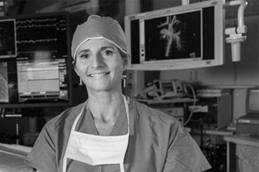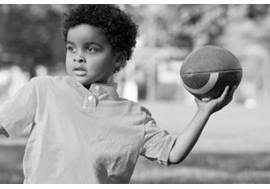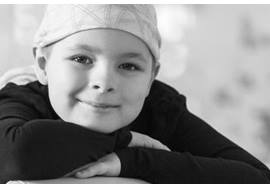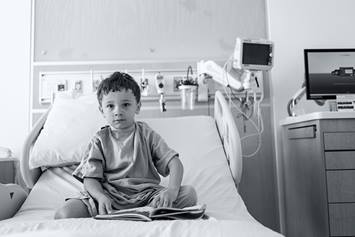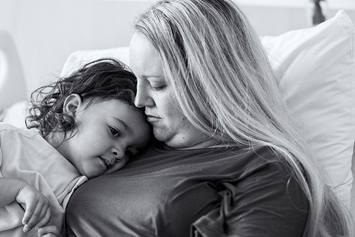Orthopedic Oncology Program
Children and adults with any type of benign or cancerous bone or soft tissue mass have access to an ultra-specialized service: the Orthopedic Oncology Program at Nationwide Children’s. With a staff devoted exclusively to the removal of these growths — including a special focus on Ewing sarcoma and osteosarcoma — our offerings lead the nation in expertise, volume and variety.
Our Orthopedic Oncology Program focuses on innovative limb salvage strategies and ways to protect quality of life both now and in the future for our patients. We are supported by a robust range of related programs at Nationwide Children’s to help maximize health outcomes, from oncology and child life to adaptive therapies and rehabilitation resources.

Nationwide Children's Hospital is ranked by U.S. News & World Report for Orthopedics.
A National Leader in Limb Salvage
Avoiding amputation can help many patients keep their limb function and appearance while still safely and effectively removing the tumor. The number of operations we do for Ewing sarcoma and osteosarcoma alone makes our program one of the largest limb salvage centers in the nation.
The Orthopedic Oncology Program at Nationwide Children’s also specializes in extreme limb salvage techniques. These techniques help us save limbs that may otherwise have required amputation, or that may have had a failed salvage operation in the past.
In addition, we are one of the few centers to offer non-invasive, expandable prosthetics. These devices can expand or grow as your child grows to keep up with the rest of their limb. The lengthening is performed in the office without an operation.
Meet the Director

Thomas Scharschmidt, MD, is director of the Orthopedic Oncology Program at Nationwide Children’s. His clinical interests focus on orthopedic surgery, bone cancer, soft tissue sarcomas, spine surgery and limb salvage. Dr. Scharschmidt’s research interests include targeted muscle reinnervation, quality of life in orthopedic surgery patients and improving outcomes after surgery for bone cancer.
Dr. Scharschmidt serves as assistant professor of orthopedics at The Ohio State University, where he runs a similar bone tumor clinic for adults. He is an active member in several professional societies, including the Radiation Therapy Oncology Group, International Society of Limb Salvage, and Orthopedic Tumor Society. Dr. Scharschmidt has more than 65 publications and trains physicians from around the world on bone tumor removal, limb salvage techniques and targeted muscle reinnervation. He received his medical degree from Northeastern Ohio University College of Medicine.
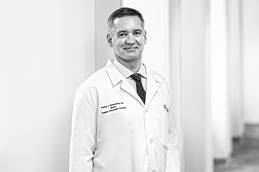
Advanced Orthopedic Oncology Procedures and Treatments to Treat Bone and Soft Tissue Tumors in Children
Orthopedic oncology involves diagnosing, treating and removing bone and soft tissue cancers. From removal to bone reconstruction procedures, the end goal is to help patients restore mobility and function as much as possible. The pediatric population is unique because they are still growing and developing. The orthopedic oncology experts at Nationwide Children's treat malignant and benign tumors of the bones and soft tissue, while considering each patient's short- and long-term outcomes.
In most cases, limb salvage is usually possible. But when it comes to limb salvage versus amputation, the main considerations include quality of life and function. Virtual surgical planning is often used to enable the surgeon to virtually view the patient's anatomy prior to performing any surgical procedure. A radiologist reviews 2D images, including MRI, ultrasound and CT scans, to develop a 3D picture of the patient's condition. The team then builds a 3D model of the tumor or bone to reconstruct the patient's anatomy to pre-plan for surgery or custom implant design. Virtual surgical planning helps the team prepare ahead of time, improves outcomes and is the standard of care at Nationwide Children's.
Treatment Options
- Arthroplasty, or joint replacement surgery, may be offered for benign tumors that involve joint destruction or severe deformity. It can be considered for conditions like giant cell tumor or aggressive chondroblastoma that compromise joint function and cause significant pain. When joint replacement is needed, we also offer comprehensive arthroplasty care. Unlike centers that perform the procedure on adults only, we have significant experience reconstructing joints in children and young adults, preserving or restoring their range of motion.
- Chemotherapy
- Curettage and bone grafting: A common procedure for benign bone tumors like enchondroma, chondroblastoma, and giant cell tumor. It involves scraping out the tumor and filling the cavity with bone graft to promote healing.
- Embolization: Pre-operative procedure to reduce blood flow to highly vascular tumors like aneurysmal bone cysts, making subsequent surgical resection safer and more manageable. The choice of surgical procedure depends on various factors, including tumor type, location, size, patient's age and functional requirements, and the extent of bone and soft tissue involvement. It's essential for the surgical team to carefully assess each case and tailor the approach accordingly to achieve the best possible outcome for the patient.
- Limb salvage surgery aims to remove the tumor while preserving the limb's function and appearance. It involves techniques such as wide resection of the tumor followed by reconstruction using metal implants, bone grafts, or biological reconstruction techniques like allografts or vascularized fibula grafts. Limb salvage surgery is commonly considered for most benign bone tumors to maintain functionality and cosmesis.
- Non-invasive limb lengthening or expandable prosthetics: These implants are controlled by a magnet to lengthen the limb instead of lengthening surgically to keep up with patient's growth. Patients are typically seen in the office every two months and lengthen at least a few millimeters each time. This is a painless approach. Devices can lengthen 6 to 9 centimeters to keep up with patient's skeletal growth.
- Osteotomy: Surgical cutting of bone to correct deformities caused by benign tumors like fibrous dysplasia or osteochondroma.
- Radiation Therapy
- Resection: Surgical removal of the tumor without limb preservation, typically considered for aggressive or recurrent tumors where limb salvage is not feasible.
- Rotationplasty is often considered for cases where a significant portion of the bone needs to be removed. It involves removing a segment of bone, rotating the remaining portion (usually the foot and ankle), and reattaching it to the upper leg. This procedure can be considered for tumors near the knee joint, such as osteosarcoma, where limb salvage is challenging. Nationwide Children's performs more rotationplasty procedures than almost any other hospital. This unique operation converts what would be an above-knee amputation to the functional outcome of a below-knee amputation. This procedure can also offer activity options not available with most prosthetic knees or above-knee amputations, such as the ability to play sports that involve heavy jumping, rotating, running or pivoting.
- Targeted muscle reinnervation (TMR) is a surgical technique used to improve prosthetic control and reduce phantom limb pain in amputees. While not typically used directly for benign tumors, it can be part of the treatment plan for cases where limb amputation is necessary, such as in advanced osteosarcoma or aggressive giant cell tumor. TMR attaches those cut nerves into the muscle around the amputation. The procedure can eliminate or prevent phantom nerve pain. It also gives children the option to eventually make use of a bio-prosthetic. A bio-prosthetic is a device that connects the nerves to the prosthetic so that people can control it using their own thoughts and nerve signals, much like a normal limb. Our team pioneered TMR in children with great success after performing dozens of successful TMR procedures in adults, and now teaches the approach to surgeons from around the world. As the world’s first center performing targeted muscle reinnervation (TMR) in children, we are leading the way toward a future with less post-amputation pain and the potential for bio-prosthetics.
A Full Range of Support Resources
Perhaps the best aspect of bone and soft tissue operations at Nationwide Children’s is the variety of highly specialized resources available to support our patients before, during and after their orthopedic oncology care.
Patients requiring visits from specialists in multiple disciplines, such as medical or radiation oncology, can have all of their appointments in one day. The physicians collaborate to make sure each patient’s care is informed, comprehensive and customized. In addition, a sarcoma-focused physician panel (tumor board) meets to discuss every single patient’s tumor and the best individualized course of treatment.
Nationwide Children offers a full range of services to support all patients with benign or malignant bone or soft tissue tumors, including:
- Comprehensive Sarcoma Program
- Surgical Oncology
- The Adaptive Sports Medicine Program
- The Limb Difference Clinic
- The Center for Limb Lengthening and Reconstruction
- Child Life Specialists
- Physical Therapy
- Occupational Therapy
- Physical Medicine and Rehabilitation
- Orthopedics
- Comprehensive Pain Services
